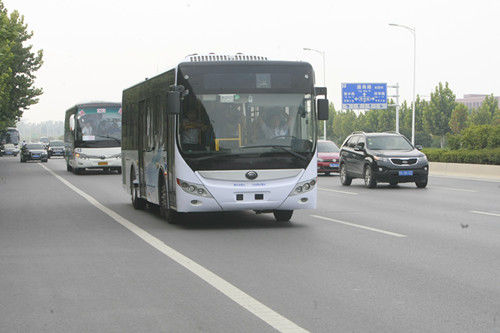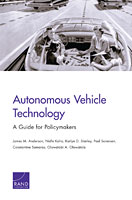Fleets of self-driving cars will reduce the cost of individual motorized mobility and increase its accessibility to people without driver’s license. Many city planners fear that this will induce additional demand and significantly increase miles traveled with the result of even more congestion in our already heavily congested cities.
Fortunately, there are many reasons why an increase in person-miles traveled with self-driving cars will not lead to an increase in congestion. The opposite may be true: we may find that self-driving cars, while certainly increasing person-miles traveled will actually reduce the congestion in our cities. Congestion is not a direct function of the number of vehicles on a road; it depends on driver actions, routes taken, road utilization per vehicle and systems for flow optimization (traffic management systems etc.). If we increase the number of miles driven and keep all other parameters constant, then congestion will certainly increase. But with fleets of self-driving cars, all of these parameters will change, some significantly.
In the following we will first look the reasons why self-driving cars are likely to reduce congestion compared to human-driven cars. Items 1 and 2 show that there is significant potential for congestion-reduction (which in turn means that the risk of induced mobility leading to more congestion is reduced).
1. Driving behavior: The driving behavior of a self-driving car differs from the driving behavior of human drivers. Autonomous cars don’t exhibit the lane-hopping and other congestion-creating behavior. Simulations have found that even a small percentage of self-driving cars among many human-driven cars on a lane reduces congestion because the self-driving vehicles help to smoothen the traffic flow. Self-driving vehicles also reduce the typical delay of the average human driver at a stop light turning green and thus ensure that more vehicles can pass that stop light in a given time frame. A self-driving vehicle will not sit idle for a second after the car in front has started moving. This number can be further increased if the self-driving car uses an optimized acceleration pattern at a stop light. Thus, with an increasing ratio of self-driving cars, the throughput will increase at the bottlenecks which will lead to significant reduction of congestion.
2) Road capacity utilization:
2a) Road space: Self-driving fleet cars used for urban driving will be smaller and thus use less road capacity. Self-driving cars will also systematically adhere to an optimal minimum distance to the car in front which significantly increases the number of vehicles that a given road segment can support during heavy traffic.
2b) Parking space: Fleets of self-driving cars will be in operation most of the time, especially when mobility demands (and with it traffic) is high. Thus cities will need much less parking space and can use parking space of other purposes. In some cases, parking spaces could be turned into additional lanes, further increasing throughput. This is an option but we expect most of the parking spaces that are freed up to be put to other use. Note that self-driving car fleets may need very little dedicated parking space because they could simply use existing lanes that are no longer needed during off-peak times or at night for parking.
2c) Convoy driving: As the ratio of self-driving cars in traffic increases, these cars will more frequently find another self-driving car in front or behind and can then coordinate their driving behavior. This can lead to further reduction of distances between the cars and can further improve reaction times at stop lights.
2d) Lane sharing: Self-driving cars can drive consistently with more lateral precision than human drivers. Thus they can operate on narrower lanes. This also makes it possible that more self-driving cars can drive next each other than the number of lanes available. For example, three self-driving cars may ride next to each other on a two-lane highway. This could be another variant of convoy driving and would need communication between the vehicles.
2e) Micro-cars: Very small self-driving pods could be built so that two of them fit next to each other on a single lane. An example has been proposed by Harald Buschbacher (although these two wheelers with auto-retractable stabilizer wheels are envisioned as personal rapid transit vehicles using their own very narrow lanes).
The previous 2 items (Driving behavior and road capacity utilization) ensure that the congestion-inducing effect of a self-driving car is much lower than the average human-driven car which in turn allows to significantly increase the number of person-miles traveled without increasing congestion. But the next item is the key reasons why we can be confident that self-driving car fleets will not increase congestion, even if they significantly increase the number of person-miles:
3) Internalizing the costs of congestion paves the way for combating congestion:
Today, congestion on our roads leads to enormous economic costs. Unfortunately, these costs are distributed among the many traffic participants which at the same time are cause and victims of congestion. It is difficult to unleash market forces to find ways for reducing congestion because it is difficult to set prices for congestion-free roads nor can we correctly attribute congestion-costs to those who cause it and make them pay. This changes once shared fleets of self-driving cars provide a significant share of local mobility because these fleets internalize a sufficiently large part of congestion costs.
Fleet managers will focus on the bottom line and they have every incentive to maximize their return on capital. They will try to minimize the size of their fleet and to maximize the throughput of their cars. To them, congestion translates directly to cost. When they send a car through a congested area, this increases the cost of the car, reduces revenue opportunities and it also reduces the throughput for other cars of the fleet that may need to take the same route a little later. After a few months of operations, fleet controllers will be able to quantify exactly how much their bottom line would improve if the throughput in a certain bottleneck could be improved by a few percent. They would find that many investments in infrastructure, signalling algorithms, routing methods etc. would have a positive return because their costs (of congestion-reducing activities) are lower than their benefits (increased fleet revenues, lower fleet size (capital stock)).
From an economic perspective, shared fleets of self-driving cars aggregate the mobility demands and the congestion-related effects of their large group of customers. This aggregation allows the fleet to find much better ways of handling congestion – taking into account both the preferences of their customers with respect to congestion-related costs, the congestion-inducing effects of different routes and mobility solutions and internal or external potentially costly mechanisms that reduce congestion. The fleet will very clearly understand (and be able to quantify) its effect and the effect of each of their customer’s trips on congestion. In contrast to the individual driver on the way to the office very morning, who is oblivious to his share in making congestion and who simply wants to take the fastest route, the fleet will not be concerned with the speed of the individual trip but will make sure that the trips are routed in such a way that the throughput of all their vehicles will be maximized. The goals of the fleet with respect to congestion are very much aligned with the goal of the city as a whole: that throughput is maximized.
This argument may sound academic. But the effects will be very real. Fleets that are small will not have a large impact on cities. But once fleets process a significant share of local mobility, they will have the best knowledge about traffic and congestion patterns in the city. Their cars will provide them with detailed up-to-the minute traffic information for all parts of the city. Economic rationale will lead them to build complex models of traffic flow and look for ways in which throughput can be improved and they will be able to very clearly indicate what approaches in which areas of the city could lead to which level of congestion reduction. They will work with city official to optimize their signaling infrastructure, they will even be willing to invest into that infrastructure (if the cost is lower than the benefits from congestion reduction). The fleets will also look for ways to shift mobility demand (so that some people defer their trips to non-peak times) and to reduce congestion cost per trip by combining trips (through ride-sharing or by inventing new variants of ride-sharing that actually appeal to their customers).
In summary, there is no reason for city managers to worry about congestion-inducing effects of shared fleets of self-driving cars. These fleets will have large benefits for the city. They will actively combat and reduce congestion because they are the first entity that internalizes the costs of congestion. They will reduce the ecological footprint of mobility because they will be mostly electric vehicles and the average vehicle will be smaller and lighter than the vehicles today. They will accelerate the transition to electric vehicles because the shared utilization of short-range vehicles is the optimal use case for electric vehicles. They will free up parking spaces and eliminate traffic looking for parking (which can be a very significant share in inner cities).
If you are still worried about the congestion-inducing effects of self-driving car fleets, here is a simple, political argument: Self-driving car fleets won’t increase congestion in our cities because we will not let that happen. Such fleets will not populate our cities over night. They will initially service a small fraction of the population and can not immediately cause significant increases in congestion. As these fleets become larger, politicians will certainly not sit idle if congestion increased and neither would the electorate accept more and clearly attributable congestion. This in turn would increase the economic pressure on such fleets to find ways for reducing congestion (the most straightforward would be to limit their size by adding congestion charges to their pricing structure).
Note: This is part of a larger series of misconceptions related to self-driving cars. The other misconceptions are discussed here. A PDF document with all misconceptions is also available for download.



